
Anthurium is a genus of about 1,000 species of flowering plants, the largest genus of the arum family, Araceae. General common names include anthurium, tailflower, flamingo flower, and laceleaf.

Epiphyllum is a genus of epiphytic plants in the cactus family (Cactaceae), native to Central America and South America. Common names for these species include climbing cacti, orchid cacti and leaf cacti, though the latter also refers to the genus Pereskia.

Disocactus phyllanthoides, the nopalxochitl or German empress, is a species of flowering plant in the cactus family Cactaceae. It is commonly grown as an ornamental houseplant. It is one of the three major species involved in creating the widely grown epiphyllum hybrids or "epis". The others are Disocactus speciosus and Disocactus crenatus.
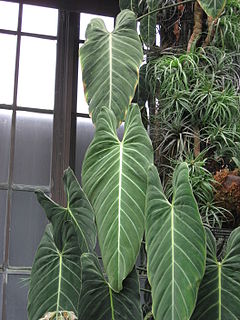
Philodendron melanochrysum is a species of flowering plant in the family Araceae, endemic to the wet Andean foothills of Colombia, growing at approximately 500m above sea level in the provinces of Chocó and Antioquia but widely cultivated elsewhere as an ornamental.

The National Botanic Garden of Bangladesh and the Bangladesh National Herbarium make up the largest plant conservation center in Bangladesh, with an area of around 84 hectares. It is located at Mirpur-2 in Dhaka,1100, beside the Dhaka Zoo. It was established in 1961. It is a botanic garden, a knowledge center for nature lovers and botanists and a tourist destination. The herbarium has a scientific collection of approximately 100,000 preserved specimens of plants.

Anthurium andraeanum is a flowering plant species in the family Araceae that is native to Colombia and Ecuador. A winner of the Royal Horticultural Society's Award of Garden Merit, it is one of the plants listed in the NASA Clean Air Study as effective in removing formaldehyde, xylene, toluene, and ammonia from the air.

The Living Rainforest is an indoor greenhouse tropical rainforest located in Hampstead Norreys in Berkshire, England. It is an ecological centre, educational centre and visitor attraction consisting of three glasshouses, operated and run by the Trust for Sustainable Living. The glasshouses are named Amazonica, Lowlands and Small Islands respectively.
Pachycladon is a genus of flowering plants of the family Brassicaceae, native to Tasmania and the South Island of New Zealand. It contains the following species:
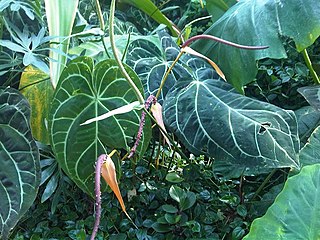
Anthurium crystallinum is a species of flowering plant in the family Araceae, native to rainforest margins in Central and South America, from Panama to Peru. Growing to 90 cm (35 in) tall and broad, it is an epiphytic perennial, characterised by large, velvety oval leaves with prominent white veining, and inflorescences with green spathes and pale green spadices throughout the year.

Anthurium clarinervium, known as the velvet cardboard anthurium, is a species of flowering plant is in the family Araceae, native to Chiapas, Mexico. The Anthurium genus is known to contain approximately 1,000 species, resulting in one of the most diverse Central American tropical plant genera.

Anthurium crassinervium is a species of flowering plant in the family Araceae, native to Venezuela and Colombia in South America, and some Caribbean islands. It was first described by Nikolaus Joseph von Jacquin in 1791 as Pothos crassinervius and transferred to Anthurium in 1829 by Heinrich Wilhelm Schott.

Anthurium veitchii, the king anthurium, is an epiphytic species of flowering plant in the genus Anthurium native to Colombia. It is grown in more temperate climates as a greenhouse or houseplant for its large, pendulous leaves that can be several feet long.
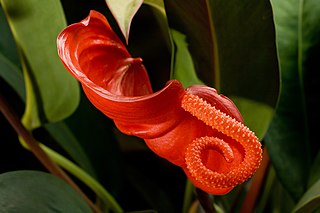
Anthurium scherzerianum, the flamingo flower or pigtail plant, is a species of Anthurium native to Costa Rica. It has gained the Royal Horticultural Society's Award of Garden Merit as an ornamental houseplant, kept at 15 °C (60 °F) or higher. It is naturally an epiphyte, growing on trees in the rainforest.
Thomas Bernard Croat is an American botanist and plant collector, noteworthy as one of botanical history's "most prolific plant collectors". He has collected over 85,000 species of plants, particularly in the family Araceae, in his career at the Missouri Botanical Garden.
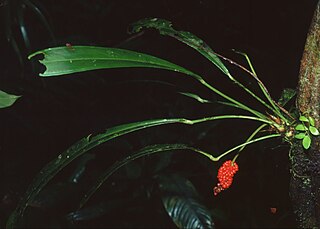
Anthurium bakeri is a species of flowering plant in the family Araceae, found from Chiapas in Mexico through Central America and on to northwestern South America. A semi‑epiphyte with strappy leaves and bright red flowers, it is occasionally sold as a houseplant.

Anthurium vittariifolium is a species of flowering plant in the family Araceae, native to the Amazon region; southeast Colombia, Ecuador, Peru, and northern Brazil. With its long, pendulous leaves it is occasionally sold as a houseplant.
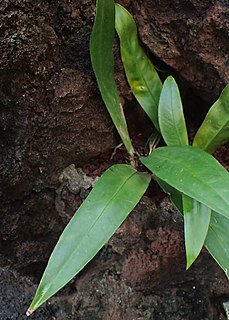
Anthurium amnicola, the tulip anthurium, tulip tailflower, or Hawaiian tulip, is a species of flowering plant in the family Araceae, native to Panama. With its tulip‑like flowers it was grown for the cut flower industry in Hawaii, and is occasionally sold today as a houseplant.

Anthurium watermaliense, the black anthurium or black prince, is a species of flowering plant in the family Araceae, native to Costa Rica, Panama, and Colombia. Its dark purple spathes make it popular as a houseplant.

Anthurium gracile, the red pearls anthurium, is a species of flowering plant in the family Araceae, native to the American tropics. An epiphyte, when kept as a houseplant it needs excellent drainage.

Anthurium cubense is a species of flowering plant in the family Araceae, native to southeastern Mexico, Central America, Cuba, Colombia, and Venezuela. A large species, it is occasionally kept as a hothouse specimen or as a house plant. With Anthurium pendulifolium, it is a parent of the 'Big Bill' hybrid cultivar, with leaves exceeding 10 ft (3 m).



















